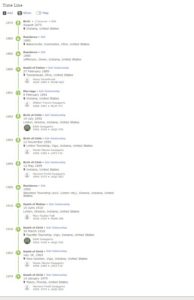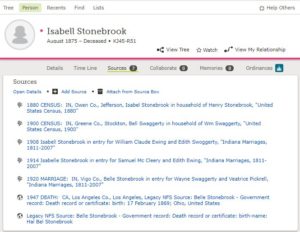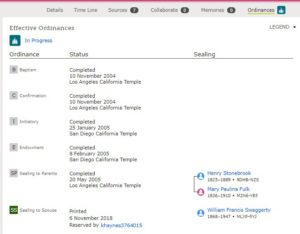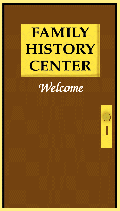
Lucky indeed are those individuals who have local FamilySearch Centers near them. In earlier decades, these facilities swarmed with individuals who came to use microfilm, fiche, and reference books not available to them easily. But today, with over a million new records being put online daily, most families have what is needed to satisfy their research aims back to at least the early 1800s available directly to their homes through FamilySearch.org or its affiliates.
The home page of this website gives the most current dates and time people are scheduled to help you in the Provo East Tri-Stake FamilySearch Center. The phone number is listed as well. You can even click the tab from the home page to schedule an appointment to meet with a consultant on a particular research problem of interest to your family. Today’s visitors come to understand how to use the new tools in FamilySearch.org, and to gain access to records that are only available at centers.
What is Available for free at a Family Search Center?
19th Century British Library Newspapers
This fully searchable database of the British Library’s newspaper holdings provides a complete run of 48 national and regional Victorian British newspapers for the 19th century from 1800 to 1900. These support the study of colonial history, genealogical research, politics, urban studies, and media courses.
Newspaper Archives
“NewspaperArchive.com is the world’s largest online newspaper archive. Featuring billions of articles from historical newspapers around the U.S. and the world, Newspaper ARCHIVE makes exploring history and genealogy easy and fun. Discover fascinating news in archived newspapers hundreds of years old-including obituaries, birth announcements, sports articles, comics, and more to fill in the life stories you are interested in. And share those stories with others through our community at Our Newspaper ARCHIVE. All of the historical newspapers are full pages and fully searchable. Try exploring the above, and discover your history today!”
Alexander Street Press – American Civil War
- Research Data: Contains indexed, searchable information on over 4 million soldiers and thousands of battles, together with 15,000 photographs. http://asp6new.alexanderstreet.com/cwdb
- Letters and Diaries: Contains approximately 100,000 indexed pages of diaries, letters, and memoirs, including 4,000 pages of previously unpublished manuscripts, such as the letters of Amos Wood and his wife and the diary of Maryland planter William Claytor. http://solomon.cwld.alexanderstreet.com
- Images, Photographs, Posters, and Ephemer : Provides a vivid history of the American Civil War with over 1,400 images. http://cpho.alexanderstreet.com
- Women and Social Movements in the United States: Organized around the history of women in social movements in the United States between 1600 and 2000 A.D.
Ancestry
Access this database at: http://www.ancestry.com
Ancestry gives you access to thousands of collections of records from around the world, including immigration, census, voter, vital, and military records; newspapers and periodicals; family trees; photos and images; directories, maps, court, land, wills, and financial records, stories, memories, and histories; and detailed records about births, marriages, deaths, land ownership, and much more. It is the largest for-profit genealogy company in the world.
ArkivDigital
Access this database at: http://www.arkivdigital.net
ArkivDigital is the largest private provider of Swedish Church Records and other historical records online! All images are newly photographed color images of the original documents.
Click the link from the Premium FamilySearch Websites page to install the current client version of ArkivDigital Online.
Find My Past
Access this database at: http://www.findmypast.co.uk
findmypast makes it easy to research your UK ancestry and create your family tree. Search census records and trace births, marriages, and deaths to bring your family history to life. Please note that not all of the content from Findmypast is available in family history centers.
1911 British Census (accessed through the Findmypast website)-The 1911 UK Census records everyone who lived in England and Wales in 1911. It provides a unique snapshot of the lives of those who lived at that time.
Find your ancestor’s Civil War, Revolutionary War, or War of 1812 service and pension papers. Search or browse millions of historical documents and photos. Fold3 has refocused its efforts on gathering the best online collection of military records and stories. The Fold3 name reflects military history and honor, since traditionally, the third fold in a flag-folding ceremony honors and remembers veterans for their sacrifice in defending their country and promoting peace in the world.
Historic Map Works – Library Edition
Access this database at: http://www.proquest.historicmapworks.com
Historic Map Works-Library Edition is one of the most extensive digital map collections available, with over 470,000 high-resolution, full-color historic and antique maps. The core of the collection consists of cadastral (property and land ownership) maps illustrating the geographic and development history of the United States and also includes illustrations, city directories, and more. This unique content allows genealogists, historians, and academic researchers to track the “residential genealogy” of families and locations.
ProQuest Obituary Listings
Access this database at: http://obituaries.proquest.com/obitsweb/obits/do/home
The ProQuest obituaries collection is a premier resource for genealogical and historical research. You can use the collection to search obituaries and death notices from prominent newspapers, such as the New York Times (dating back to 1851). The collection includes both famous and lesser-known individuals and can be searched by name or by keywords appearing in the body of the article.
Puzzilla – Premium Services [edit source]
Access this database at: https://puzzilla.org
Find new research opportunities on descendant lines in Family Tree.
Access this database at: https://www.worldvitalrecords.com
Access to birth, marriage, and death records; Social Security Death Index; family trees; census records; immigration records; court, land, and probate records; military records directory lists; newspapers, family histories, reference materials, biographies, wills, gravestone photos, ship manifests, map collections, and yearbook collections.
Proper log-in through the portal is confirmed by a “Welcome FamilySearch Center Patron!” banner on the web page. Also, the World Vital Records error message: This Data Is NOT Available To Your Library (53204) is for an explanation of some data that may not be available.
The FamilySearch Library Catalog, now called CATALOG, at FamilySearch.org also acts as a locating guide. Regular gazetteers, maps, and atlases may also be used and they may be found online with the help of a Temple and Family Search Consultant.
A FamilySearch Center requires no fee to attend. Temple and Family Search Consultants are trained in the use of equipment, holdings, and basic techniques of research but they are not expected to do research for patrons. They are guides to lead patrons to the various source materials, rather than to be research assistants. However, if you find someone interested in your area of the world, you often will find very qualified research specialists ready to help. You may have a difficult time keeping them from helping you if they know you need help.
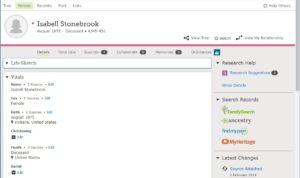 This is the most important page in FamilySearch Family tree. There should eventually be just one Person Page for every person who has lived. It is our goal to pull together information from multiple Person Pages who may have information on our ancestor into one accurate page by locating sources that resolve conflicts between dates, places, events, and relationships.
This is the most important page in FamilySearch Family tree. There should eventually be just one Person Page for every person who has lived. It is our goal to pull together information from multiple Person Pages who may have information on our ancestor into one accurate page by locating sources that resolve conflicts between dates, places, events, and relationships. Finally, you can always see the Latest Changes on your family by clicking the words in blue: Show All. As you scroll down the Person Page, you will come to the Other Information area, and start to see the Family Members. Other Information includes variant name spellings such as Belle for Isabelle, or different residences she lived in as found on original sources.
Finally, you can always see the Latest Changes on your family by clicking the words in blue: Show All. As you scroll down the Person Page, you will come to the Other Information area, and start to see the Family Members. Other Information includes variant name spellings such as Belle for Isabelle, or different residences she lived in as found on original sources. At the top of the Person Page below where the person’s name is recorded, there are links to a Time Line, Sources, Collaboration, Memories, and Ordinances. The time line can take details from Hints, documents you link, and field of information you enter when the person is first entered to build a time line of their life events. This is not just for show. This helps remind you of other places where records could be found.
At the top of the Person Page below where the person’s name is recorded, there are links to a Time Line, Sources, Collaboration, Memories, and Ordinances. The time line can take details from Hints, documents you link, and field of information you enter when the person is first entered to build a time line of their life events. This is not just for show. This helps remind you of other places where records could be found.